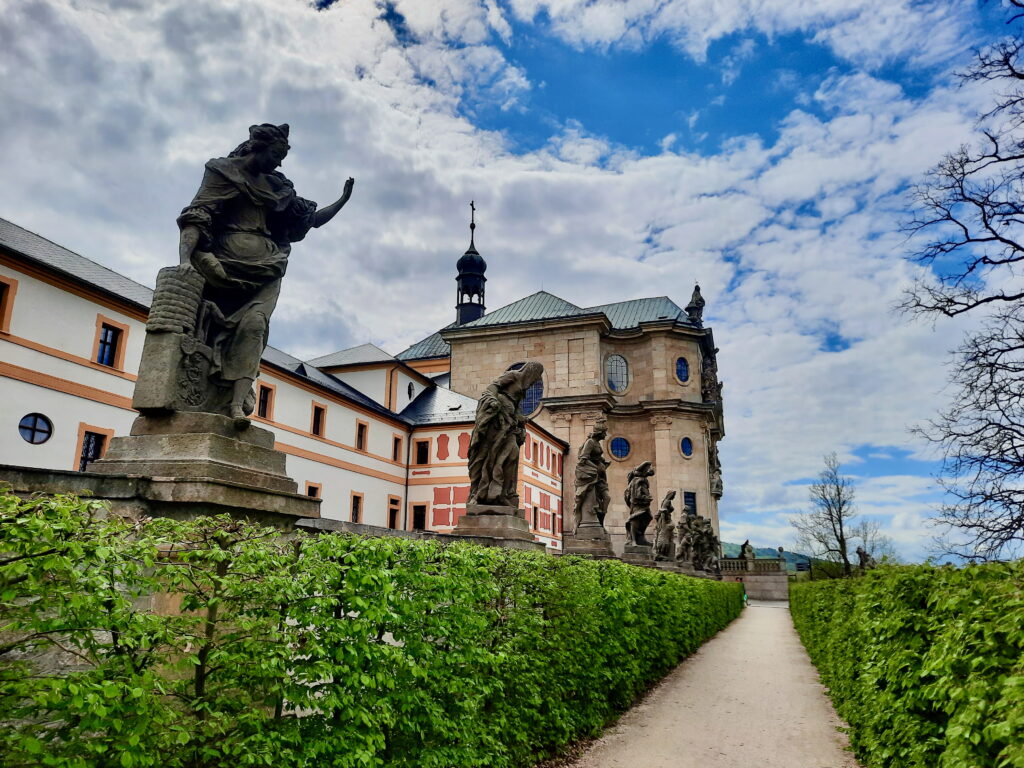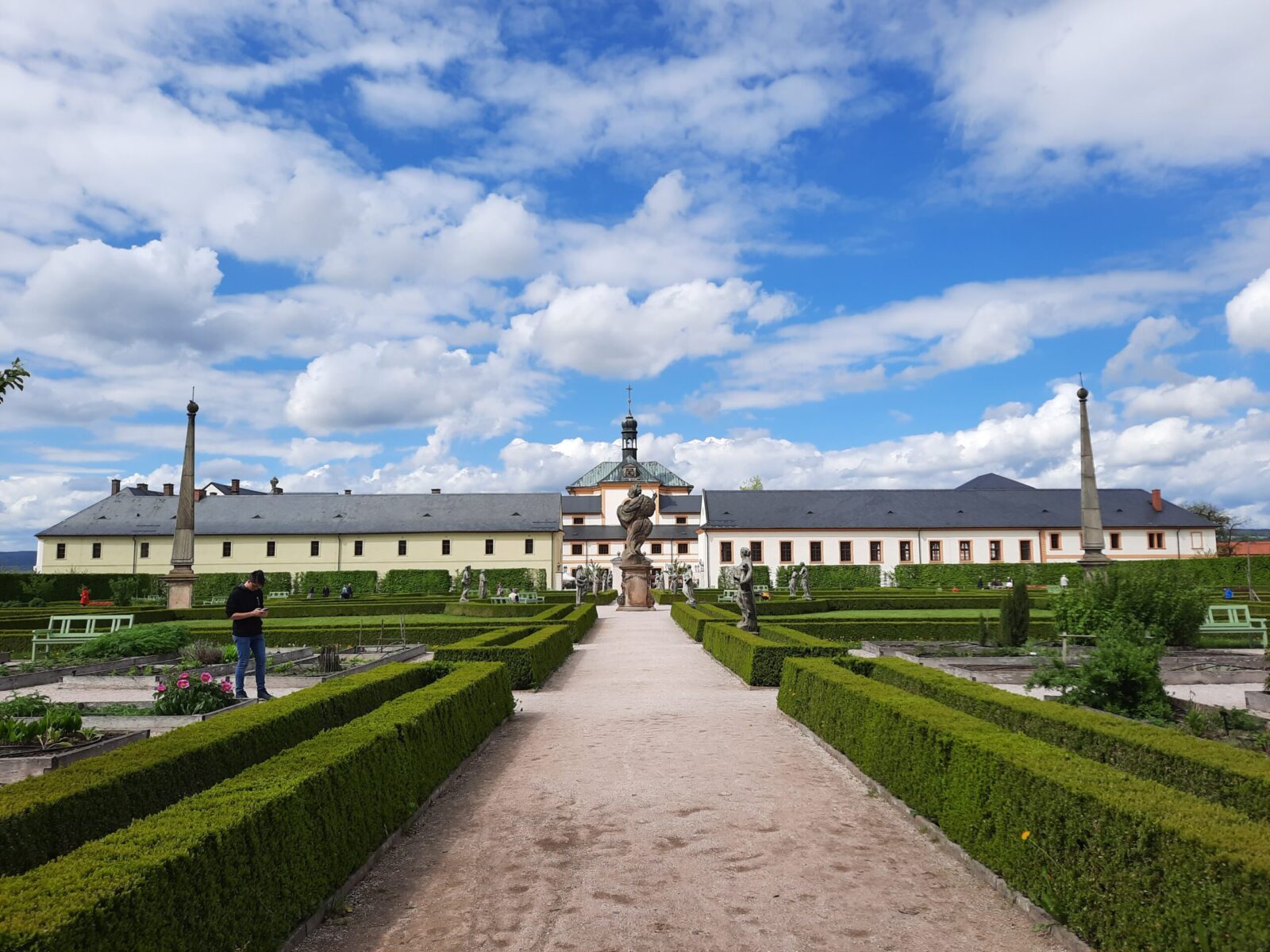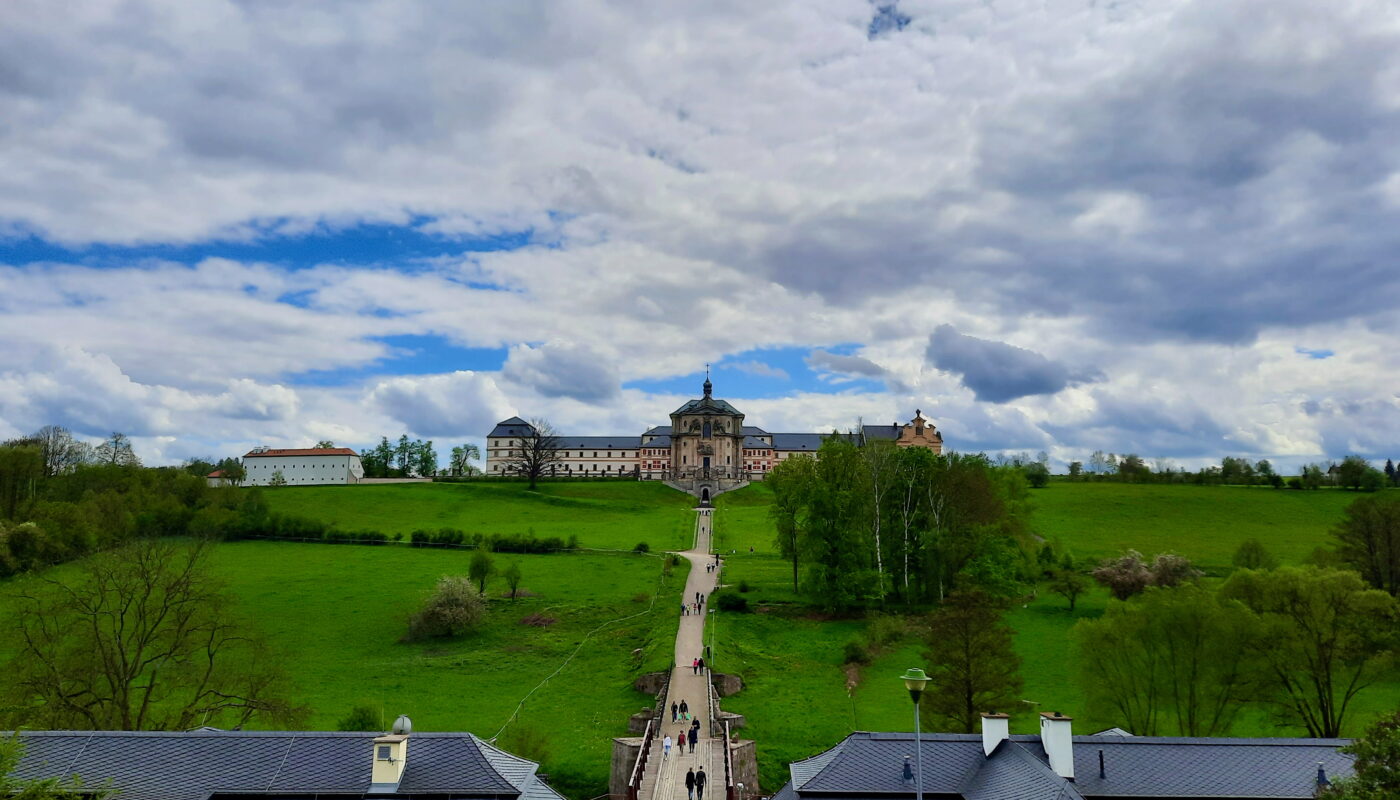Reading Time: 6 Minutes 28 Seconds
General info
In the valley of the Elbe River, north of Hradec Králové, there is a magnificent Baroque complex: the Kuks hospital.
The complex is a National cultural monument since 1995 and it is renowned today not only for the hospital.
In this magical place you can admire the monumental Church of the Holy Trinity, the cycle of wall paintings titled “The dance of death”, the allegories of virtues and vices, and one of the oldest preserved baroque pharmacies in Central Europe, known as the pharmacy “At the pomegranate” (in Czech,“ U granátového jablka ”).
History of the area
Count František Antonín Špork inherited the estate in the Elbe valley in 1684, and ten years later he embarked on an ambitious and extremely expensive project: the transformation of the Kuks valley into a spa and social center for the nobility.
Its construction involved internationally renowned artists, such as the engraver Michael Heinrich Rentz, the painter Petr Brandl, the architect Giovanni Battista Alliprandi, and the sculptor Matyáš Bernard Braun.
The area was designed as a mirrored image on an axis perpendicular to the Elbe River: the buildings on the left bank (north) were used for social life, those on the right bank (south) were intended for more spiritual matters.
The project was successful and the Kuks baths were classified among the most famous in Europe, named together with Karlovy Vary and Baden Baden.
The left bank (north)
All the structures on the left bank – the houses, the theater, the inn, the windmill and even the spa building – were made of wood.
The first stone building was erected in 1704 in a location above today’s cascading staircase.
The lower part of the house was transformed into a spa area with twelve bath rooms, and on the first floor there was a reception hall, with a portico that opened onto the beautiful surrounding valley.
Count Špork’s family lived on the second floor for a part of the year, and for this reason the spa house was called the castle.
While many of the wooden houses are still standing, the castle was demolished around 1900.
The right bank (south)
The hill on the right bank was dominated by a hospital, with the Church of the Holy Trinity.
The construction of the church, with an irregular octagonal plan, began in 1707.
The project was designed by the Italian architect Giovanni Battista Alliprandi, while the builder Pietro Antonio Netolla and stonemason Giovanni Pietro della Torre supervised the construction.
The construction of the hospital started a year later.
This facility was intended to provide a resting place for retired and disabled individuals from Count Špork’s estate.

Additionally, a hospital garden was established, and a cemetery with a chapel was later added.
The terrace in front of the Church of the Holy Trinity was decorated with eight statues of the Beatitudes, along with the statues of the angels of the Blissful Death and Sorrowful Death and of Religion, all created between 1712 and 1718.
Both sides of the terrace feature a series of statues representing the allegories of the twelve virtues and twelve vices.
The statues are the work of the famous sculptor Matyáš Bernard Braun.
In 1738, František Antonín Špork died without witnessing the hospital’s operation.
Two years later, a storm and a flood destroyed most of the buildings, including the bridge over the Elbe,
This event marked the end of the once glorious thermal baths, of which no trace remains today.
The hospital
The hospital began its operation in 1743, when the count’s daughter, Anna Kateřina Šporková, invited the congregation of the Brothers of Mercy.
It operated until 1938, when the monks and their patients were forced to leave the building due to the Munich agreement.
Following this event, the complex served various purposes over the years, functioning as a warehouse, a school, a local history museum, and reformatory.
At the end of the war, Germans fleeing the Red Army sought refuge here.
At the end of the 1950s, a project was created to save the baroque complex.
In 1958 the building was declared a national cultural monument, but mistakenly recorded with the name “Kuks Castle”. Only in 1995 it was recognized as a hospital.
The hospital as we see it today reopened to the public in March 2015, after a long renovation.
The pharmacy
The Merciful Brothers established the pharmacy and called it “At the pomegranate”, as the fruit that symbolizes rebirth.
Today, it has been transformed into the Pharmacy Museum, managed by the Faculty of Pharmacy of the University of Hradec Králové, and it hosts two permanent exhibitions on the history of Czech pharmacy.
On the museum’s shelves you can still find potions made of dragon’s blood, shrimps’ eyes, and the powder of the executioner’s skull.
The first exhibition is called “The magic of Apothecary” and it focuses on the development of pharmacy as a discipline. During the tour you explore the original office of the Brothers of Mercy, dating back to 1743, as well as the pharmacy warehouse, which stores samples of herbs, minerals and animals.
Visitors can put themselves in the pharmacist’s shoes and create tablets and suppositories by crushing chemical elements with a mortar, or sign recipes and give advice on the use of medicines.
The second exhibition, “From Pharmacy to Factory”, traces the history of drug production and it is the only one of its kind in the Czech Republic.
This tour presents the development of drug manufacturing from small-scale production in pharmacies to industrial production in factories, up until the mid 20th century. Here you can see restored original equipment and machinery, used for the preparation of medicines.
The herb garden
The herb garden has been located behind the hospital building since its establishment in the 18th century.
Medicinal plants have always been cultivated here for the local pharmacy, as well as fruits and vegetables for the hospital kitchen.
The garden’s significance diminished around 1945, when the pharmacy and hospital were permanently closed, but its restoration in the 2000s revitalized its importance.
The herb garden is now freely accessible and open daily from sunrise to sunset.

The dominant feature of the herb garden is a statue of a Christian warrior, created in 1732 in the workshop of the sculptor Matyáš Bernard Braun.
At both sides of the warrior there are two obelisks, which were once located on the banks of the Elbe.
The central path of the garden is bordered by thirteen statues by Bartolomeo Zwengs, which represent the arts and the seasons.
In the right corner of the garden, you can find a statue of the Angel of Glory, and reliefs of cherubs embedded in the surrounding wall.
The Nativity of Braun
Matyáš Bernard Braun also created a natural gallery of Baroque sculptures in the forest a few kilometers from Kuks.
These statues are carved in sandstone and the work is called “The Braun Nativity” (in Czech, Braunův betlém).
To see the statues there is a 7 km natural loop trail called “Let’s go to Bethlehem Together”, that starts from and ends at the hospital.
Otherwise, you can drive to the other side and park at one of the two available parkings, the free one or the paid one.
On the route, there are informative panels, which explain the history of each individual sculpture.
Obviously they are in Czech, so either skip them, or you can use the camera option on google translate.
Originally, the entire work of the nativity consisted of 26 sculptures, but only 10 remain today: the reliefs “Adoration of the shepherds” and “Arrival of the Three Kings”, the relief “Vision of St. Hubert “, the sculpture of a Christian soldier representing count Špork, the statue of the angel Glory, “Jacob’s well”, the statues of the hermits Onofrio (or Noferi) and Garinus (Juan Garín), and the ones of Mary Magdalene and of St. John Baptist.
Tourist information
The Kuks hospital complex is usually open from April to November with different schedule, depending on the season.
You can find the information you need on the official website and on their facebook page, where they post all the events and many beautiful photos.
To can get to Kuks by car, train or bike.
- If you travel by car be aware that parking spots are limited and paid.
- If you choose to travel by train, the journey from Prague takes around 2 hours, with a transfer in Jaroměř before continuing to Kuks.
The train station is conveniently located right at the entrance to the gardens, behind the hospital. - If you prefer riding a bike, you can combine Kuks with “Les Království” dam in one day. I posted the trail in this article.

